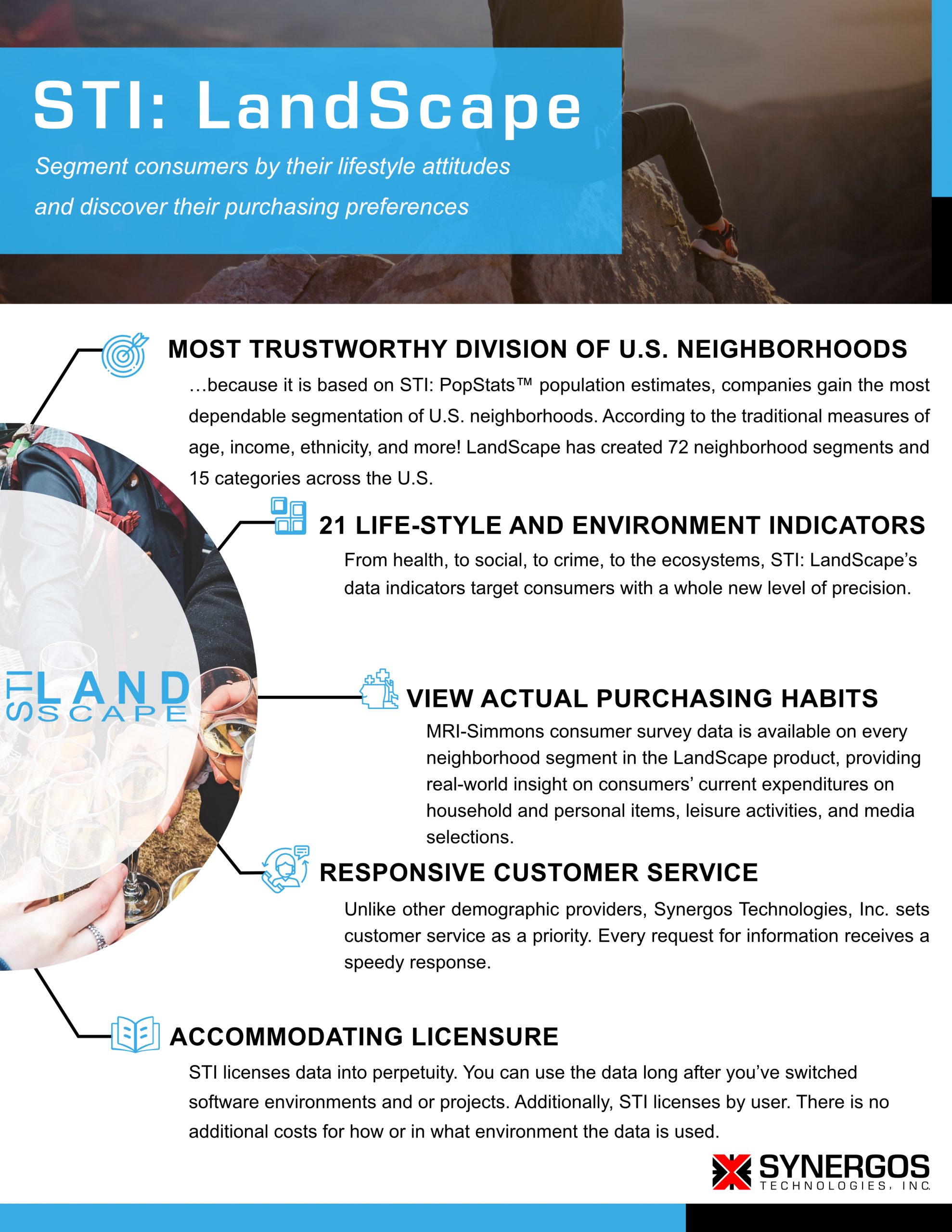STI: LandScape™ – Lifestyle Segmentation
A psychographic dataset with 72 lifestyle segments to create your perfect customer profile
STI: LandScape™ – Lifestyle Segmentation
A psychographic dataset with 72 lifestyle segments to create your perfect customer profile
Having a psychographic dataset is crucial now more than ever in this day of social. Consumers hold individualistic attitudes on a wide range of topics — from health to politics, to technology adoption. Each consumer’s unique attitudes influence his or her lifestyle choices. And their lifestyles impact their purchasing decisions on cars, clothing, food, entertainment, and more.
Knowing consumers’ unique lifestyle attitudes has numerous business implications — from site selection to merchandising, to marketing. However, there has not been a dependable way to cluster consumers according to their lifestyle attitudes — until now.
The STI: LandScape™ product is an innovative neighborhood segmentation system created specifically to segment consumers by both traditional demographic factors and by their lifestyle attitudes. As a result, LandScape data goes far beyond other segmentation systems — and gives companies deeper levels of actionable consumer insight at the block-group level.
When you choose LandScape data to segment consumers, you gain more dependable geodemographic neighborhood segments, access to 21 unique Lifestyle and Environmental Indicators, and the option to view consumers’ real-world purchases on thousands of items.
Test STI: LandScape™ in Your Trade Area
STI: LandScape™ Features & Benefits
STI: PopStats™ Data Dependability
| Access consumer segmentation based on the most accurate population estimates available today – including 15 neighborhood categories and 72 segments |

10 Unique Lifestyle Indicators
| Discover five social and five health indicators that influence consumers’ purchasing propensities, based on data from leading U.S. agencies |

11 Unique Environmental Indicators
| Understand consumers from 11 environmental perspectives, including crime and migration, based on data from leading U.S. agencies |

Syndicated Consumer Survey Data
| Learn what consumers are buying now on household, entertainment, and media, based on Mediamark’s trusted consumer panel survey data |
Seamless Data Integration
| Gain easy access to LandScape data – which works on all existing research engines |
Free GIS Tools
| Leverage a wealth of GIS data from the online STI: Data Depot, and use STI: ISIS, an executive-level reporting software – all free to STI clients |
Flexible Licensing Terms
| Obtain generous licensing terms, including the use of previous year’s data, authorized data use beyond purchase year, and minimal data-use restrictions |
Market Research Insight
| Attend STI’s Annual Research Conference – which provides a forum to share research, knowledge, and best practices about LandScape data and other STI products |
Responsive Customer Service
| Enjoy STI’s industry-leading customer service – the highest in the research industry |
LandScape data delivers the most trustworthy division of U.S. neighborhoods
Because it is based on STI: PopStats™ population estimates, companies gain the most dependable segmentation of U.S. neighborhoods. According to the traditional measures of age, income, ethnicity, and more, LandScape has created 15 neighborhood segments and 72 categories across the U.S.
Allows researchers to add 21 Lifestyle and Environmental Indicators to their market analysis
From health, to social, to crime, to the ecosystems, LandScape data’s Indicators target consumers with a whole new level of precision.
Provides the option to view consumers’ actual purchasing habits
Mediamark’s consumer survey data is available on every neighborhood segment in the LandScape product, providing real-world insight on consumers’ current expenditures on household and personal items, leisure activities, and media selections.
No other neighborhood segmentation system delivers the depth and breadth of consumer lifestyle intelligence that LandScape data provides. If you want to gain greater knowledge of your consumers, LandScape data will provide the most detailed and actionable consumer views available today.
What can STI: LandScape™ data help you build today?
- STI: LandScape™
- Methodology
- Deliverables
Test STI: LandScape™ in Your Trade Area
Unleash your research potential and enjoy greater confidence in your research with 72 lifestyle segments — with today’s leading psychographic dataset.
